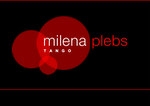
Torsión & pivot.
El cambio de dirección durante el baile del tango es producido por una oposición de cadera y hombros, con la columna vertebral como eje y vértice en la cintura. Como consecuencia se genera en el pie de base, afirmado en el metatarso, una rotación normalmente llamada pivot. Este mecanismo combinado es funcional tanto a la guía masculina como a la respuesta femenina de diversa forma según el rol.
See english translation below
María Mondino y Pablo Inza . Chicago Tango Week 08
Foto / Photo: Alejandro Almanza
Gran parte de la habilidad en la danza consta del manejo fluido de esta instancia y sus infinitas aplicaciones. Podemos decir que los dos elementos esenciales de este baile en pareja son el caminar y los cambios de frente, provocados por la mecánica del abrazo o enlace. El “ocho”, figura básica del tango, consta de un paso o cambio de peso y un pivot. Este último es particularmente interesante, ya que es la llave que abre las múltiples posibilidades del baile. De su dominio muchas veces depende la calidad del desempeño en la pista o el escenario. El pivot en el pie es la consecuencia concreta de la torsión de la parte media del cuerpo.
Suelo decir en las clases que sería conveniente tener bien “aceitado” este mecanismo con todo lo que ello implica: buen funcionamiento de propuesta y respuesta a través del abrazo en ambos participantes, eje y acople de la pareja, y la capacidad de medir la rotación de la espiral que este sistema motriz produce a cada impulso dado o recibido.
Es interesante explorar en el rol de la mujer el estado corporal durante la torsión y el pivot. Es la situación durante la que suceden los cambios y estos pueden ser verdaderamente inesperados. Por tal motivo es aconsejable trabajar y experimentar la máxima alerta física, capacidad de rápida respuesta y a la vez permitir cierta relajación que favorezca la receptividad de lo que puede suceder. Para lograrlo es útil disponer de herramientas dinámicas como el trabajo de tensión y relajación complementarios, equilibrio y un buen entendimiento del encuentro bailado. En la tarea masculina, el manejo de la torsión tiene que ver con una acción voluntaria, o sea con su control, y también es valioso su estudio en la manera adecuada. Esto permite mayor despliegue creativo en el baile e incrementa su armonía.
Pero con este desarrollo no quiero decir que haya que generar un pivot más pronunciado que el necesario. Sólo se trata de, en relación con el todo, investigar sus matices y posibilidades en la posición correspondiente: la de estímulo y consecuente transformación de los involucrados en la danza. •
Copyright © El Tangauta 2008
Torsion & pivot.
An opposition of hip and shoulders produces the change of direction while dancing tango, with the backbone as axis and the vertex in the waist. As a consequence a rotation normally called pivot is generated in the base foot, where the weight is supported by the metatarsus. This combined mechanism is functional both to the male lead and the female answer, in different ways depending on the role.
Great part of the ability in tango centers in the fluid management of this instance and its infinite applications. We can say that the two essential elements of this partner dance are the walk and the changes of direction, caused by the mechanics of the embrace or link. The "ocho", a basic figure in tango, is formed by a step or change of weight and a pivot. This last one is particularly interesting, since it is the key to open the multiple possibilities of the dance. From controlling it depends many times the quality of the performance both on the dance floor and the stage. The pivot of the foot is the concrete consequence of the torsion of the middle part of the body.
I usually say in my classes that it would be convenient to have this mechanism well “oiled” with everything that this implies: good performance of both the proposal and the answer of the dancers through the embrace, the couple’s axis and the way their bodies are joined, and the capacity to measure the rotation of the spiral that this motion system produces on each impulse given or received.
In the role of the woman, it is interesting to explore the state of the body during the torsion and the pivot. This is the situation during which changes happen and they can be truly unexpected. This is why it is advisable to work on and experience maximum physical alertness, the capacity to quickly answer and at the same time to allow for a certain relaxation that favors being receptive to what may happen. To achieve this is useful to have dynamic tools such as the work of tension and complementary relaxation, balance and a good understanding of the dance encounter. As for the man side, the management of the torsion has to do with a voluntary action, that is to say with its control, and it is also valuable to study it. This allows for a wider creative range in the dance and increases its harmony.
But with this development I do not mean to generate a more pronounced pivot than it is necessary. It is only a matter of investigating it, as it relates to the whole of the dance, its nuances and possibilities in the corresponding position: that of stimulus and consequent transformation of those involved in the dance.
Copyright © El Tangauta 2008
Publicado en El Tangauta - EDICION nro 169
Traducción: Dolores Longo.






No hay comentarios:
Publicar un comentario